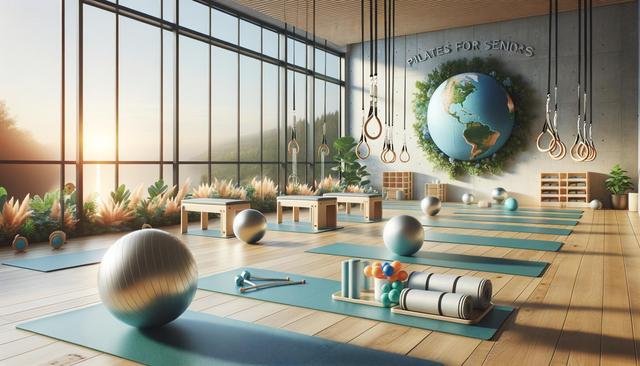Understanding Pilates and Its Benefits for Older Adults
Pilates is a low-impact exercise method focused on controlled movements, core strength, and body awareness. Originally developed in the early 20th century, it has gained popularity among older adults seeking a way to stay active without placing undue stress on their joints. For seniors, Pilates offers several unique advantages that align with the natural needs of aging bodies, such as improving posture and reducing the risk of falls.
One of the key principles of Pilates is the emphasis on quality of movement over quantity. This makes it especially suitable for those who may face limitations due to arthritis, joint replacements, or other conditions. The exercises can be adapted to different mobility levels, and many routines can be performed on a mat or with supportive equipment like exercise balls and resistance bands.
Benefits of Pilates for seniors include:
- Improved core strength, which supports spinal alignment
- Enhanced balance and stability, reducing the risk of falls
- Greater flexibility and range of motion
- Increased body awareness and concentration
- Reduced stiffness and joint discomfort
Whether practiced in a group class or at home with guidance, Pilates offers a gentle yet effective way to maintain physical health and independence.
Building Strength Without Strain
As we get older, maintaining muscle mass becomes increasingly important for daily function and quality of life. Pilates helps strengthen muscles throughout the body using slow, deliberate movements that avoid high impact or heavy lifting. For seniors, this means they can build strength in a safe, controlled environment.
Unlike traditional weight training, Pilates emphasizes the use of body weight and resistance equipment like reformers or resistance bands. These tools allow for a full-body workout that promotes muscular endurance and joint stability without overstressing the body. Pilates movements also focus on eccentric contraction, where muscles lengthen under tension—a technique shown to be effective in improving strength with minimal risk of injury.
Key strength-building exercises in Pilates for seniors may include:
- Leg circles to strengthen the hips and thighs
- Wall roll-downs for spinal flexibility and core engagement
- Arm raises with light resistance to build upper body strength
- Modified planks or bridge poses for lower body and core support
By regularly incorporating these exercises, seniors can maintain or even improve their strength, supporting their ability to perform everyday tasks with more ease and confidence.
Enhancing Balance and Preventing Falls
Falls are one of the leading causes of injury among older adults, but many of them are preventable with the right fitness approach. Pilates includes a variety of exercises designed to improve balance, coordination, and proprioception—the body’s ability to sense its position in space. This aspect of Pilates is particularly beneficial for seniors, as it helps build the physical and mental awareness necessary to navigate their environment safely.
Balance-focused Pilates exercises typically engage the core while promoting alignment and stability through the legs and feet. Some routines incorporate props like a stability ball or foam roller to challenge the body further and encourage coordination. Breath control and mindful movement also help seniors stay focused, which can reduce the likelihood of missteps.
Examples of balance-enhancing Pilates exercises include:
- Standing leg lifts with support
- Heel-to-toe walking drills
- Single-leg stands with light arm movement
Practicing these movements regularly can significantly reduce the risk of falls and improve overall confidence in mobility. Many seniors report feeling more secure and stable in their daily routines after committing to a Pilates regimen.
Supporting Mental and Emotional Well-being
Physical health is only one part of the equation for aging well. Pilates also supports mental and emotional well-being by fostering mindfulness, reducing stress, and promoting a sense of accomplishment. The practice encourages participants to focus on their breath and movement, which can have a calming effect and improve mental clarity.
For seniors who may be dealing with loneliness, anxiety, or the emotional challenges that come with aging, Pilates offers a structured and positive outlet. Group classes can foster social connection, while individual practice provides time for introspection and self-care. The non-competitive nature of Pilates also makes it an inviting space for those who might feel intimidated by other forms of exercise.
Mental health benefits of Pilates for seniors include:
- Reduced stress and anxiety through focused breathing
- Improved mood from regular physical activity
- Enhanced cognitive function through concentration and coordination
- Increased self-confidence from mastering new movements
Overall, Pilates can be a valuable tool for maintaining not just physical health, but mental resilience and emotional balance in later years.
Getting Started Safely and Effectively
For seniors interested in trying Pilates, starting slowly and safely is key. It’s always advisable to consult a healthcare provider before beginning any new exercise program, especially for individuals with chronic conditions or recent surgeries. Once cleared, choosing the right type of Pilates class or instructor can make a big difference in the experience.
Many fitness centers and community centers offer Pilates classes specifically designed for older adults. These classes often move at a slower pace and incorporate modifications to accommodate different abilities. For those who prefer to exercise at home, there are a number of videos and online programs tailored for senior Pilates practice. Look for certified instructors with experience working with older populations.
Tips for getting started:
- Start with a beginner-level class or video
- Use props like cushions or yoga blocks for extra support
- Focus on form and breathing over intensity
- Progress at your own pace and listen to your body
By taking a mindful and gradual approach, seniors can experience the many benefits of Pilates while minimizing the risk of injury or discomfort. Consistency is more important than intensity, and even a few sessions per week can yield noticeable results over time.




Leave a Reply